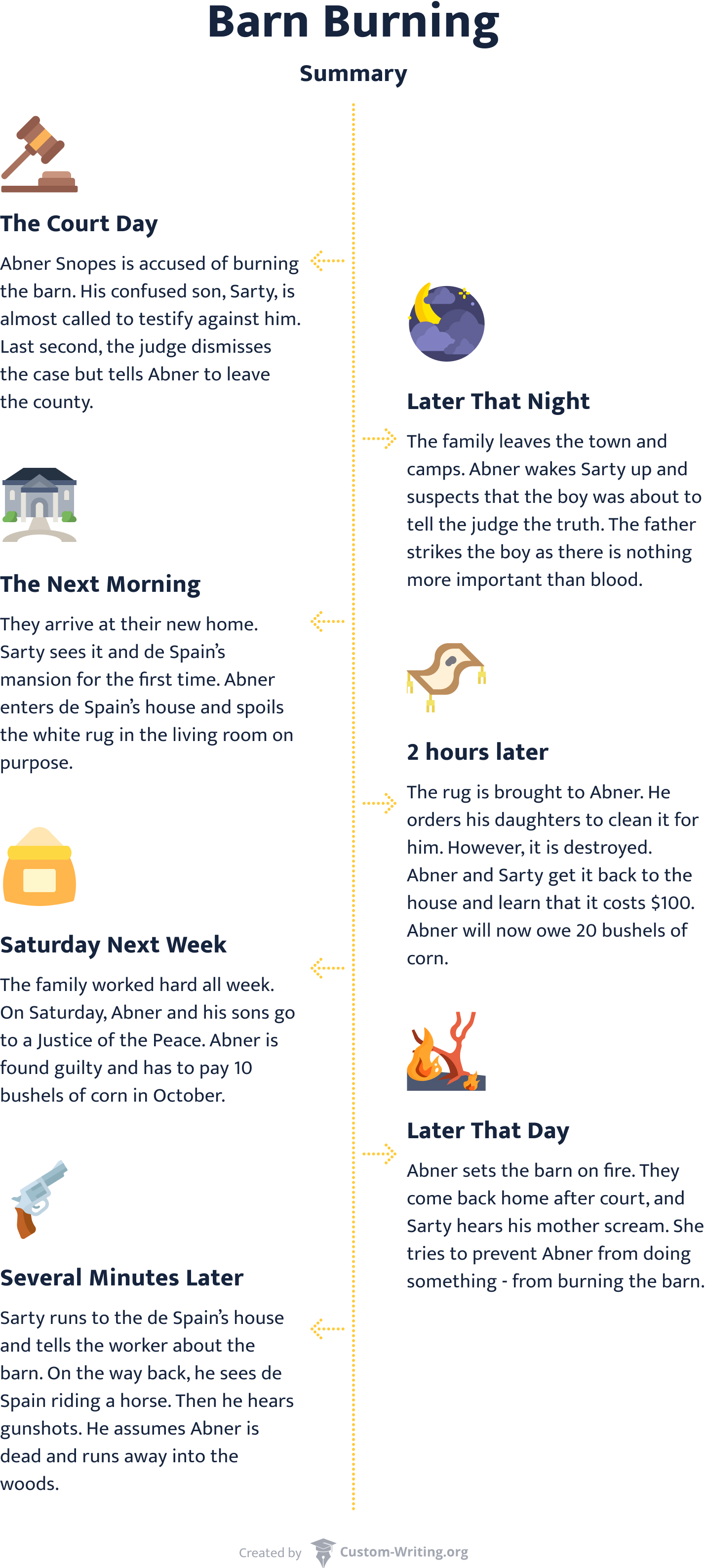Welcome to our William Faulkner “Barn Burning” summary that highlights all the major turning points of the story:
Abner Snopes is accused of burning his neighbor’s barn but escapes punishment. After moving to a new farm, he ruins Major de Spain’s rug and is fined. Seeking revenge, Abner plans to burn de Spain’s barn, but his son Sarty warns the landowner and then runs away from his family.
If you’re interested in learning more about the story, its characters, and themes, this guide by Custom-Writing.org experts is for you. Here, you’ll discover a detailed summary of “Barn Burning” by William Faulkner, along with a visual plot infographic. Besides, you’ll find here a comprehensive “Barn Burning” analysis that examines the short story’s setting, conflicts, voice, and more.
Barn Burning by William Faulkner: Summary Infographic
Looking for a short summary of “Barn Burning” in a visually appealing format? Check out this comprehensive plot infographic!

Barn Burning: Summary
“Barn Burning” by William Faulkner is a profound short story. It starts with a court proceeding at a store, not a courthouse. In this proceeding, Abner Snopes is accused of burning his neighbor’s barn. Mr. Harris, the opponent of Abner, tells the Justice that on several occasions, Snopes’s hog broke through the fence and got into his fields. The last time it happened, Mr. Harris asked for a dollar in return. A man who went to get the hog told Mr. Harris that the barn and the corn could burn. That very same night, Mr. Harris lost his barn to fire. However, there is no real proof of who caused the accident.
The only eyewitness is a ten-year-old boy, the son of Abner. His name is Colonel Sartoris Snopes. He is called by the Justice to answer some questions. Essentially, he will have to testify against his father and is ready to lie for Abner. He sees the court as his enemies and doesn’t realize that Justice and Mr. Harris are being kind to him. They don’t want to put Sarty in an uncomfortable position. That’s why, instead of pressuring the boy to testify against his father, the Justice dismisses the case. Nevertheless, he recommends Abner leave the country the very same day. Abner agrees to do that.
As Abner and his sons leave the store, someone harasses the father by calling him “a barn burner.” Sarty is ready to prove his loyalty to the family and wants to fight. The boy knocks down Sarty two times, and Sarty bleeds.
In the evening, the whole family packs their belongings into a wagon and leaves the city. In the middle of the night, Abner wakes Sartoris up to accuse the boy of being disloyal. He thinks that Sarty was on the verge of betraying the whole family. He strikes Sartoris and tells him to “stick to his own blood.”
Later, the family arrives at their new home. The reader learns that it is not the first time when they had to move. They moved on a dozen occasions just in the last ten years. The author doesn’t explicitly explain why they did that. It’s also revealed that the family will work on the land owned by Major de Spain. Abner despises the owner of the land because he is rich. The house of Major de Spain is described in great detail.
As soon as they arrive, Abner goes to de Spain. He steps into the horse droppings on purpose just before entering the mansion. However, the owner is not at home. Abner goes into the center of the room and leaves dirty shoe marks on the blond rug. Miss Lula, the owner’s wife, asks them to leave. She is displeased with the guests. He leaves the house and remarks that all of it has been built by slaves.
Several hours later, the servant from the house brings the rug for cleaning. Abner orders his daughters to clean the carpet. However, the next morning, de Spain arrives early in the morning to tell them that the rug is ruined. Its replacement will cost one hundred dollars, and they will be additionally charged twenty extra bushels of corn. Sarty tries to defend his father, hoping it will help him.
The next several days, the whole family is busy with labor. On the weekend, Abner Snopes and his sons go to the country store again. They find de Spain in the store. Sarty doesn’t understand that his father tries to sue De Spain to have the penalty of twenty bushels removed. However, the judge thinks that the rug was burned as well. He says that Snopes will have to pay with ten extra bushels of corn when it is due.
When Snopes returns home, Abner hears his mother’s voice. She tries to stop Abner from doing something. However, he takes the kerosene from a lamp and orders Sartoris to get the oil. Sarty realized that his father wants to burn another barn. The boy agrees to do that but is thinking of running away. Then, he tries to change his father’s mind, but his attempts are futile.
Sartoris runs to the de Spain house to let them know about the barn. As Sartoris runs back to the barn, he hears three shots. He also sees the firelight from the burning barn. Snopes is dead, and Sartoris mourns. He doesn’t know for sure if Abner is dead.
Sarty falls asleep and wakes up feeling better. He runs away into the dark woods without looking back.
Barn Burning Analysis
Barn Burning Setting
The setting of “Barn Burning’s” first part is unknown. However, the events of the opening scene supposedly happen in the southern United States. The second part of the story occurs in a fictional county of Yoknapatawpha in the state of Mississippi. A lot of Faulkner’s works take place there.
Barn Burning Analysis: Stream of Consciousness
Faulkner’s “Barn Burning” features the author’s distinct literary style. There, he uses long sentences that are interrupted by the clauses. It gives a sense of continuity to his works and creates a stream of consciousness in which the characters’ thoughts are interrupted and shifted.
The opening paragraph is the perfect example of how Faulkner uses this technique. The scene focuses on the feelings and thoughts of a ten-year-old boy named Sarty. The first thing the readers learn is that he is hungry. He craves meat and cheese while standing at a store. The first paragraph describes his thoughts and physical sensations. His mind quickly shifts. He remembers the reason why he is in the store. He has to testify against his father in a court hearing.
Young Sarty faces a choice: to be loyal to his father or stay faithful to what is morally right. He knows that his father burned the barn. However, he is ready to lie for him. The reader doesn’t know if it’s out of fear or love. Sarty’s impressions and feelings are loosely connected. Overall, the opening paragraph goes from the description of hunger and scents to the abstract sensations: guilt, fear, anger, and contradiction.
Let’s now examine Sarty’s inner conflict. The boy is convinced that Justice and Mr. Harris are his and his father’s enemies. He doesn’t notice that they behave kindly with him as they demand honesty and decide to dismiss the case. The reader has access to Sarty’s thoughts, but Sarty cannot put his conflict in words. Nevertheless, it’s clear that he faces a difficult choice.
Throughout the story, Faulkner traces Sarty’s personal development. By the end of it, Sarty’s self-awareness grows, and he can now act out of his motives. The critics usually overlook the significance of Sarty as the main character. They focus on the father figure in the story. However, the subtle tracing of Sarty’s personal development is essential for understanding the story.
Barn Burning Explained: Narrative Voice
“Barn Burning” by Faulkner contains examples of several modernist techniques and devices. The first one is the stream of consciousness we’ve already mentioned. Another modernist technique used in “Barn Burning” by Faulkner is the narrative voice that demonstrates Sarty’s limited understanding of his conflicts. Let’s examine it in detail.
The story takes place over one week. These events happened in the past, but Faulkner managed to create a sense of the present time. The reader might even assume that the narrator of the story is a grown-up Sarty. However, it’s not so, and here’s why.
Pay attention to how the narrative voice silences the pain and anger of Sarty and the other family members. For instance, when Abner hits Sarty, the narrator focuses on Abner and how he hurts his son. This hints at the fact that the narrator of the story is not Sarty; it is omniscient. We see the events through the eyes of Sarty, but the boy is alienated from his family and his feelings. Similarly, the reader is alienated from the main characters’ emotions, which we can view as a modernist technique.
Another thing to note is that the narrator uses advanced language which a ten years old boy would hardly use. They also possess information Sarty doesn’t know. For instance, Sarty wonders why his father doesn’t make big fires when they camp. The narrator has information about Abner’s life that Sarty does not know, which proves that they are not the same person. It creates tension because the narrator knows everything about each character. He does not sympathize with Sarty, nor he condemns Abner.
Analysis of Barn Burning by William Faulkner: Main Conflicts
There are several essential conflicts in the story: the one between Abner and De Spain and Sarty’s internal dilemma. The central part of the story happens on De Spain’s plantation. The conflict between De Spain and Abner develops immediately. Mainly as a result of the father’s actions. Sarty’s internal conflict unveils throughout the story.
Thanks for reading our analysis and summary of “Barn Burning!” You can continue analyzing the story and write an essay on “Barn Burning” with the help of our topics and samples. If you’re about to write an essay on the topic, don’t forget to include all the necessary elements.











